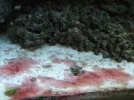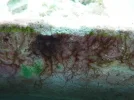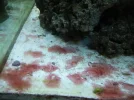Hi All!
Sorry I haven't posted in a while. Everything has been running smoothly, and everybody seems to be happy. But in the past few weeks I've started to notice pink "blotches" on my sandbed, which seem to be getting deeper, and spreading. I can also see that it seems to be deeper in the sand bed (by looking at the pictures next to the glass).
I can siphon it out, but it just comes right back the following day. I'm at a point now where I'm siphoning and doing small water changes almost daily. It seems to be futile though.
The cyano (if that's what it is) is only on the sand. (By the way my sandbed is less than 2" deep). I haven't seen it on any rocks or corals.
My inhabitants are a clownfish / BT Anenome, a Chromis, Foxface, and a Coral Beauty. Also have two emerald crabs, a peppermint shrimp, and several hermits and snails. Water parameters are fin; Ammonia 0, Nitrates 0, and Nitrites >10.
I have attached pictures. As a sidenote I thought I was getting some great coralline growth; but it all seems to be disappearing. Can that be a sign of another problem?
Pictures are attached. Please let me know what you think,
Thanks!
BK
Sorry I haven't posted in a while. Everything has been running smoothly, and everybody seems to be happy. But in the past few weeks I've started to notice pink "blotches" on my sandbed, which seem to be getting deeper, and spreading. I can also see that it seems to be deeper in the sand bed (by looking at the pictures next to the glass).
I can siphon it out, but it just comes right back the following day. I'm at a point now where I'm siphoning and doing small water changes almost daily. It seems to be futile though.
The cyano (if that's what it is) is only on the sand. (By the way my sandbed is less than 2" deep). I haven't seen it on any rocks or corals.
My inhabitants are a clownfish / BT Anenome, a Chromis, Foxface, and a Coral Beauty. Also have two emerald crabs, a peppermint shrimp, and several hermits and snails. Water parameters are fin; Ammonia 0, Nitrates 0, and Nitrites >10.
I have attached pictures. As a sidenote I thought I was getting some great coralline growth; but it all seems to be disappearing. Can that be a sign of another problem?
Pictures are attached. Please let me know what you think,
Thanks!
BK




